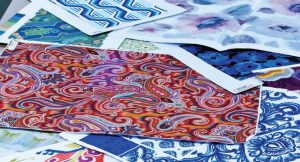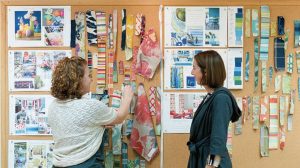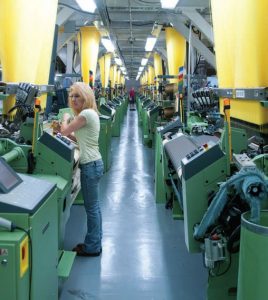 American textile manufacturers have found the secret to thriving
American textile manufacturers have found the secret to thriving
TW Special Report
We’re living in an age of globalization, automation and instant gratification.
That’s exciting, but it can spell trouble for some manufacturers. Those who can’t operate at breakneck pace and meet ever-evolving customer demand are forgotten; those who can keep up sometimes sacrifice product quality and customer relationships to do so.
But American textile manufacturers have found the secret to thriving. Two such companies, Sunbury, Pa.-based Sunbury Textile Mills and Valdese, N.C.-based Valdese Weavers Inc., are creating upholstery fabrics to meet the unique customer needs of today.
These companies are market leaders in the United States thanks to their long-term dedication to quality, customization, innovation and customer service.
Editor’s Note: Since this article originally appeared in NCTO’s Textures magazine, Glen Raven Inc., a global provider of performance fabrics, signed an agreement to purchase Sunbury. Under the agreement, Sunbury will become a wholly owned subsidiary of Glen Raven and will operate as part of Glen Raven Custom Fabrics LLC, best known as the maker of Sunbrella® fabrics.
Quality Is Paramount
Quality is a significant differentiator between domestic products and those made overseas.
“Most of the products you can purchase from overseas manufacturers are not anything special,” said Mark Grigalunas, senior vice president of styling and design at Sunbury Textile Mills. “The makers of those fabrics are playing a price game; they can’t compare to the quality of upholstery materials made in the United States.”
While quality is a major point of emphasis for U.S.-based companies, successful American textile manufacturers must also be nimble. How quickly a new trend or fabric style is adopted and produced can impact customer perception of the company and future growth.
“Whether it’s aesthetics, performance or other criteria, the market is constantly changing,” said Blake Millinor, chief sales and marketing officer at Valdese Weavers. “American manufacturers are much better positioned than their global counterparts to identify trends and adjust quickly.”
 Customization Drives Production
Customization Drives Production
Today’s consumer is looking for eye-catching fabrics that can withstand the wear and tear of daily life and make a personal statement about his or her tastes and lifestyle.
Superior customization capabilities allow manufacturers to meet this demand.
“Working with customers to create unique custom fabrics is essential in today’s market,” said Laura Levinson, chief creative officer at Valdese Weavers. “That includes differences in construction, fiber, color and weave.”
As American manufacturers continually adjust to meet high expectations when it comes to custom upholstery fabric, a common theme emerges: performance.
“Interiors are becoming more casual with a focus on the family room,” Levinson said. “Stain-resistant and stain-repellent upholstery materials are taking off in the home segment.”
But customers want more than durable fabric. They want durable fabric that is also soft, welcoming and beautiful.
“Customers today have higher expectations and demands for fabric styles and performance than ever before,” said Tom Notaro, senior vice president of sales and marketing, Sunbury Textile Mills. “They want a high aesthetic with soft texture and performance properties that come together in a highly desirable, valuable product.”
 Innovative Technology And Infrastructure
Innovative Technology And Infrastructure
Providing quality materials in a short time frame requires the highest technical capabilities.
That’s one reason why American upholstery manufacturers remain committed to innovation. Robust computer systems provide enormous support to manufacturers, not only in creating unique designs, but also in optimizing production and quality throughout the supply chain.
“Advanced software allows us to generate designs in a short amount of time,” Levinson said. “Our design system is fast and powerful and is completely digital, from the loom to fabric finishing. This gives us critical advantages in the breadth of design options and speed to market.”
According to Notaro, investing in a state-of-the-art infrastructure also helps American upholstery manufacturers stay ahead of offshore competitors.
“Sunbury annually invests in new equipment,” Notaro said. “We invest in our company every year, from systems to design tools. If American companies stand still, global competition will catch up. It’s imperative to keep moving forward.”
Relationships Are The Fabric Of Business
But perhaps the most significant advantage American upholstery makers have is not something you can find in new machinery or on a financial report.
“There’s no replacement for building deep, loyal relationships with customers,” said Mike Shelton, president and CEO, Valdese Weavers. “At Valdese, we don’t sell what we make, we make what we sell. Our creations are usually a custom fabric collaboratively developed with a client. We are always trying to meet their needs.”
Meeting the needs of the customer is one aspect of the relationship. Reliability is another.
“Our customers are more than willing to work with us because they know our time frame on bringing their designs and creations to life,” Grigalunas said. “When we quote production and delivery dates, they know it’s the truth. We don’t make promises if we can’t deliver.”
And for many of the most successful American textile mills, relationships and loyalty aren’t limited to customers.
“Our people live and work in our communities,” Notaro said. “We are a local, American-driven company that invests in our people. We care deeply about our employees and associates. They are our foundation, and they will continue to drive our success.”
Editor’s Note: This article appears in Textile World courtesy of the National Council of Textile Organizations (NCTO) as part of the “American Textiles: We Make Amazing™” campaign. NCTO is a trade association representing U.S. textile manufacturing. Please visit ncto.org to learn more about NCTO, the industry and the campaign.
September/October 2017




